Kantar's latest research shows that a warning regarding COVID-19’s human-to-human transmission nature, coming from a CCTV interview with one of the most trusted medical advisors Zhong Nanshan on January 20, has greatly promoted self-protection among the public. The proportion of people wearing masks went up from 19% to 72%, and 54% started to use various disinfection products, compared to 10% beforehand.
Zhong is a well-known Chinese pulmonologist and a member of the Chinese Academy of Engineering, who was widely acknowledged for leading the fight against the 2003 SARS outbreak, and has been respected by the Chinese public as a leading medical expert in epidemiology and pulmonology.
Our survey found that due to the impact of this epidemic, 94% of the respondents claimed that if a COVID-19 vaccine can be approved for launch, they are willing to take the vaccine.
In order to understand the levels of health awareness, beliefs and behaviour changes during the epidemic, and how health behaviour and attitude will shift in the future once the outbreak is over, Kantar launched the nationwide WeChat survey Health Awareness and Behaviours during the COVID-19 Epidemic, on February 11. We designed the questionnaire based on the "Knowledge Attitude Belief Practice" (KABP) model. We are presenting the main findings below to provide some insights to medical professionals, institutions and the life sciences industry.
CHAPTER 1. Survey Demographics and Basic Information
We managed to collect 1,729 valid samples for the survey, covering 28 provinces on the Chinese mainland and representing the regional severity of the epidemic. Specifically, 453 (26%) respondents resided in Hubei Province. Inside Hubei, a large number of respondents came from Wuhan City (47%), the epicenter of the COVID-19 outbreak.
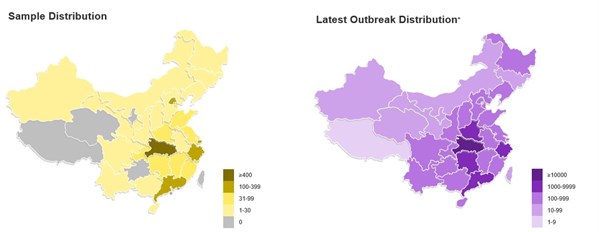
* Source: China official statistics, by February 19
CHAPTER 2. Awareness and Key Protection Approaches during COVID-19 Epidemic
Based on the knowledge about COVID-19 that was introduced in the "Novel Coronavirus Pneumonia Diagnosis and Treatment Plan (Provisional; 5th Edition Revisions)" (Note 1), we asked the respondents about some of the most relevant knowledge points. Results showed that the overall perception is good (more than 82% answers were correct), only "infected patients must have symptoms”, and “there are no asymptomatic infections" and "COVID-19 infection has high mortality" need to be reiterated and educated among public (correct ratio is about 60%).
Regarding the basic prevention measures of the epidemic, all the respondents generally believed that they have chosen the right type of mask and are wearing it correctly, and are washing their hands properly, as well as are keeping their indoor environment clean and well ventilated. However, it is worth mentioning that still a small portion of people (about 15%) did not reduce visits to relatives, friends or dining together during the epidemic.
Among all respondents, 39% indicated that their relatives, friends or contacts were confirmed and/or suspected cases of COVID-19, and 29% were living in/had been to Wuhan and/or five other major outbreak cities (Xiaogan, Huanggang, Jingzhou, Huangshi or Xiangyang). Our results showed that this specific segment had a clearer understanding of the basic knowledge of the disease, and had adopted more comprehensive prevention and control measures. Hence, we believed that the population-at-risk were more knowledgeable about the disease and were paying attention. Indeed, they have spent more time on learning epidemic information (about 0.7 hours more, p <0.05), and paid more attention to personal or family protection.
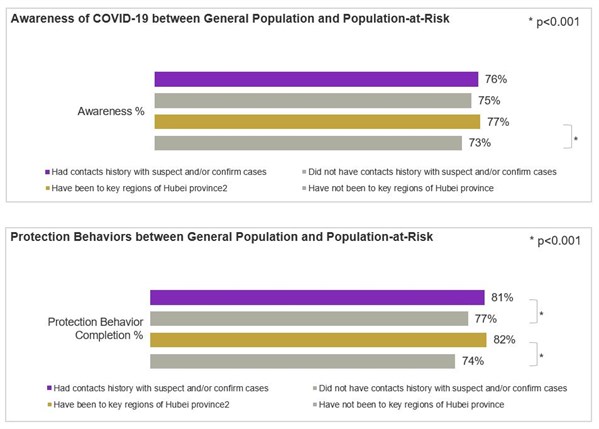
Our data showed that many factors contributed to the public’s clear understanding of the epidemic knowledge and better prevention actions:
- The public paid more attention to the epidemic information, as on average, they spend about 2 hours per day to get relevant information. Additionally, respondents in Hubei, Zhejiang, Henan, Anhui provinces and other areas having more infected patients spent even more time in keeping up the epidemic updates, in which population-at-risk spent about 2.7 hours;
- Most of the respondents (65%) were very interested in getting information about the epidemic in various aspects;
- Respondents said information coming from official media (> 90%), professional media, and digital governmental platforms (about 50%) are more trusted ad reliable. Only 6% respondents trusted information their relatives and friends forwarded through social media.

Our research also focused on the four milestones during the development of the outbreak, as well as identified the behaviour changes over different stages:
- Beginning of the outbreak (December 30 to January 20)
- After Zhong Nanshan’s warning of disease’s human transmission nature (January 20 to January 23)
- After the start of Spring Festival holiday, also when Wuhan was locked down (January 23 to February 3)
- After nationwide control of entering/leaving residential communities (after February 3 until now)
Results showed that most of the respondents started to wear face masks (19% to 72%) and wash their hands more frequently (7-10 times or more from 30% to 47%), using disinfection products (such as bleaching powder, disinfecting laundry detergent, UV lamps, etc.) (10% to 54%). The proportion of people taking prevention actions has increased to a very high level ever since.
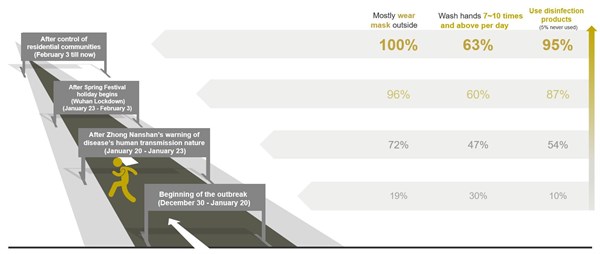
CHAPTER 3. Major Impacts of Epidemic
The epidemic has affected, and will affect, many aspects of people’s lives in the short-term and long-term, such as family income and lifestyle, emotional status, and changes in health behaviour. Our data showed that 76% respondents will take influenza or pneumonia vaccines in the future, 58% will visit a Community Health Center first when they need medical services in the future; and 64% are inclined to purchase commercial critical illness insurance.
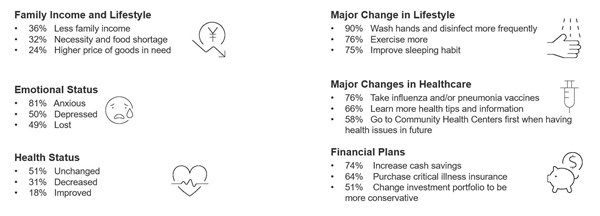
Our research also shed some lights on the medical treatments of those who had health conditions prior to the outbreak. Most of these respondents still preferred to go to hospitals (76%), especially top-level hospitals (56%). More interestingly, even in Hubei Province, 52% of surveyed respondents with health conditions still chose level III hospitals.
At the same time, our results also showed that about 15% of patients with non-COVID-19 conditions chose to use online platforms for consultation, diagnosis and treatment.
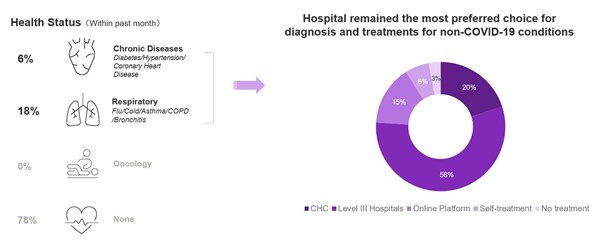
We also surveyed the public opinion towards future vaccination decisions: the vast majority (94%) are willing to receive a COVID-19 vaccine when it is launched. This is a significant increase compared to approximately 72% of the respondents that indicated they had taken at least one influenza or pneumonia vaccine in the past 10 years.

Moreover, Big Data/Digital Healthcare played an essential role during the outbreak. People learned about the latest outbreak updates, asked for treatments about their non-COVID-19 conditions, and sought psychological counselling via online channels. The top three most mentioned digital healthcare platforms are Tencent Medpedia, Ali Health and Ping An Good Doctor.
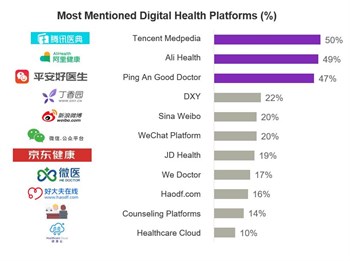
We have also further segmented the population-at-risk. Our data showed that in both the short-term and long-term, the epidemic appeared to have more impact on people having contacts, relatives, friends or neighbours becoming suspected and/or confirmed cases. Their health status, methods to seek medical consultancy and way of working have changed. People who have been to provinces/cities with high number of patients have also showed similar changes.

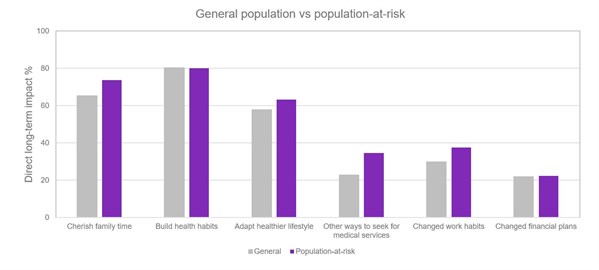
CHAPTER 4. Conclusion
In general, the Chinese population has a good understanding of COVID-19, and most of them have taken adequate prevention and control measures, such as choosing and wearing the correct type of masks, washing hands correctly and frequently, as well as keeping the indoor environment clean and well ventilated. We believe that that has founded an essential foundation of controlling this epidemic. Additionally, population-at-risk paid more attention to information about the disease and spent significantly more time on it. They have also taken more measures to protect themselves or family members.
We would like to further emphasise that this epidemic has impacted people’s lives in various aspects – from family income, lifestyle, and emotional status to future health behaviour and habits in seeking medical services. In addition to being willing to take potential COVID-19 vaccines, most people will also receive flu, pneumonia and other related vaccines in the future. They will also choose community health centers as their preferred option when seeking medical services, as well as consider purchasing critical illness insurance through commercial channels.
Moreover, Big Data/Digital Healthcare played an important role during the outbreak. People learned about the latest outbreak updates, asked for treatments about their non-COVID-19 conditions, and sought psychological counselling via online channels. Online consultation platforms or remote medical assistance has become an important channel of diagnosis, counselling and medical consultancy. It indicated a huge growth potential for Big Data/Digital Healthcare in the future in China.
Kantar's health team contributors to this article:
- Julia Liu, HEOR & Market Access Senior Director
- Ryan Li, Senior Consultant
- Lingni Li, Biostastician
- Summer Miao, Senior Analyst
- Wendy Du, Analyst
Editor's notes
Note 1: By the time the survey was launched, the official guidelines for COVID-19 prevention and treatment were the fifth edition.

